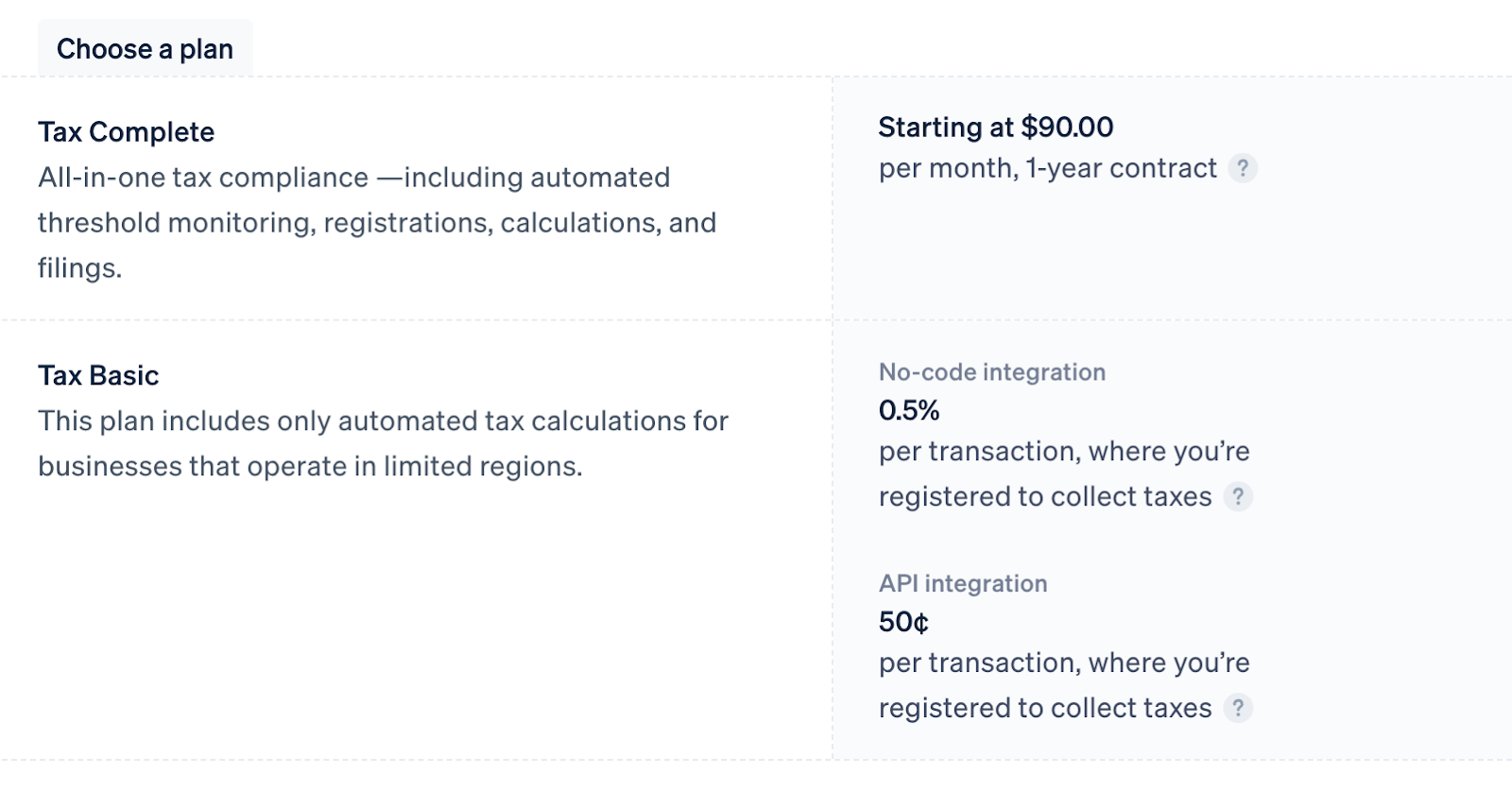If you run a growing business, you already know that sales tax compliance can be a significant challenge.
Laws about sales tax nexus and the taxability of physical products, digital products, and software vary widely from state to state, and things become even more complex when your business expands outside of the U.S. and becomes subject to additional requirements such as e-invoicing and real-time reporting. So having a robust tax automation solution is key if you want to avoid the risk of costly compliance issues.
That’s where sales tax compliance software comes in.
The right compliance tool will make your life much easier by accurately calculating sales tax on your orders, handling real-time reporting mandates, tracking nexus, and providing you with the information you need to stay compliant.
In this article, we’re going to compare two of the most popular sales tax compliance platforms for software businesses: Avalara and Stripe Tax.
Company overviews
Avalara
Avalara has been helping companies with sales tax compliance for decades and has established itself as a leader in the space. It’s known for having one of the most extensive sales tax databases on the market, which allows Avalara to assist companies with charging the proper sales tax rates almost anywhere they might have customers.
The platform automatically calculates sales tax, manages exemption certificates, and provides end-to-end compliance coverage and audit support. And its API-first approach allows you to integrate it seamlessly into your existing tech stack.
Stripe Tax
Stripe Tax is a player in the growing market of sales tax compliance solutions that are built into payment platforms. It was built with digital businesses in mind and is part of Stripe’s extensive payment processing ecosystem. And since Stripe Tax is part of that ecosystem, companies that are already using Stripe can start using it without having to spend a lot of time and money integrating new software.
Stripe Tax has a growing list of features that includes nexus tracking, reporting, and partner-based filing assistance.
Key considerations
When choosing a sales tax compliance solution, businesses should keep a few key requirements in mind, including:
- Nexus tracking: Having the ability to closely monitor where you have economic nexus is critical for any company that sells to customers in multiple jurisdictions. Avalara has a robust suite of nexus management tools, such as customizable alerts and automated workflows. And Stripe Tax provides built-in nexus tracking that’s tied directly to Stripe transaction data, so it’s very accurate if you are billing entirely with Stripe.
- Compliance across jurisdictions: Cross-jurisdictional compliance is key for ecommerce and software companies, given the complexities involved with selling a product in many different jurisdictions (which have varying laws regarding that product’s taxability). Avalara supports tax calculation for nearly every country, while Stripe Tax currently supports more than 100 countries and is working on adding to that list.
- International requirements: Selling to a global customer base means that you have to consider not only sales tax but also VAT compliance, GST compliance, and currency conversions. Both platforms have these features; however, Avalara has support for more countries and regions.
Feature comparison
There are some general features that you should factor in when choosing a sales tax compliance solution, like:
Focus and scope
Avalara provides its customers with a comprehensive suite of tax compliance solutions that are designed from the ground up to serve the full lifecycle of sales tax and indirect tax management.
The platform can provide users with everything from real-time tax calculation to exemption certificate management, automated filing, audit defense, and global tax compliance. This all-encompassing scope makes it a great choice for software companies with complex tax obligations in multiple jurisdictions.
Stripe Tax is designed to provide sales tax compliance within the Stripe payment ecosystem. With its Tax Complete package, Stripe Tax can monitor and alert users regarding their tax obligations and handle tax registration, calculation, collection, and filing in more than 100 countries. This makes Stripe Tax great for businesses that are using the Stripe payment platform.
Tax calculation and coverage
Avalara’s tax engine, AvaTax, is powered by an extensive and continuously updated database covering thousands of U.S. tax jurisdictions and nearly 200 countries. This enables Avalara to calculate accurate taxes on a wide range of physical goods and digital products, including subscriptions, licenses, and SaaS. It supports complex rules around sourcing, nexus, and product taxability, ensuring compliance with rapidly changing regulations.
Stripe Tax provides real-time tax calculations with an emphasis on SaaS and digital goods. It supports all U.S. states and a growing number of international markets, automatically applying correct tax rates based on customer location. Although its global tax content is less extensive than Avalara’s, Stripe Tax is working to add more territories and tax scenarios relevant to SaaS providers.
[blog-post-inline-cta]
Integration
Avalara integrates with practically every major business software application, allowing companies with external ERP, billing, and management systems to integrate seamlessly with Avalara’s sales tax compliance software. This helps businesses reduce the overall amount of manual data entry that’s required, which reduces the risk of error.
Stripe Tax is designed with the Stripe network in mind, so for companies using Stripe, implementing Stripe Tax is a matter of a few mouse clicks. Additionally, its API-first design makes it easy for developers to integrate it with external systems.
Nexus tracking and management
Avalara provides sophisticated nexus tracking tools that monitor sales thresholds across all applicable jurisdictions, automatically triggering compliance workflows when thresholds are met. Users receive alerts and can manage nexus profiles directly within the platform.
Stripe Tax leverages Stripe transaction data to offer built-in nexus tracking, helping customers identify where tax obligations arise without separate tracking tools. This integration simplifies compliance for companies with growing and changing footprints. However, if you are billing through multiple systems, for example, with Quickbooks and Stripe, viewing nexus through the lens of just Stripe data will provide an incomplete picture.
Tax filing
Avalara supports fully automated sales tax filing in many U.S. states and international jurisdictions, including remittance and return generation. It also offers audit defense services, helping businesses maintain compliance confidence and reduce the risk of audits.
Stripe Tax currently provides filing assistance through manual processes and partnerships with third-party providers. While it offers comprehensive reporting tools to facilitate filings, its filing features are less developed than Avalara’s, making it better suited for companies handling filing internally or through advisors. Funny enough, Avalara is a filing partner on Stripe’s app store.
Reporting, invoicing, and analytics
Avalara delivers advanced reporting capabilities, including detailed audit trails, exemption certificate tracking, and customizable reports designed to meet the needs of growing finance organizations. These insights support internal controls and regulatory reporting.
Stripe Tax provides tax reporting through Stripe’s dashboard, offering real-time views of tax collected by jurisdiction. While reporting features are straightforward and user-friendly, they are less extensive than Avalara’s, reflecting Stripe Tax’s focus on simplicity.
Customer support and resources
While Avalara is largely praised in its G2 reviews, with 4 out of 5 stars (based on more than 650 reviews), there is one area where it seems to consistently fall short, and that is in the customer service department. There are many complaints about Avalara’s customer service team, so this is definitely something you should consider before making the commitment. If your team requires extensive support, this may not be the right product for you.
Stripe Tax does have a G2 page, but it has only three reviews, so it’s hard to get a clear consensus of what people think. The Stripe page has 4.3 out of 5 stars (based on more than 800 reviews), as Stripe has become a core part of the e-commerce and SaaS industries over the course of the past decade. People like the service overall, citing that it’s an incredible platform for integrations and ease of use.
In comparison, Numeral has a 4.8 out of 5 rating on G2.
Pricing and scalability
Unfortunately, Avalara doesn’t have any pricing tiers, primarily because the majority of companies that use Avalara require a custom quote. Pricing depends on several factors, including the jurisdictions covered, the modules you select, and the number of API calls your company makes. However, you can expect to pay between several thousand dollars and more than ten thousand dollars per year for Avalara. Although Avalara is quite pricey, it is a solution that is incredibly scalable.
Stripe Tax, on the other hand, provides its pricing on its website. Its Tax Complete package starts at $90 per month, billed annually, and scales depending on the number of registrations, transactions, and filings required each year. Its Tax Basic plan offers just calculation and collection of sales tax, and costs $0.50 per transaction for the API integration, or 0.5% per transaction for the no-code integration.

While Stripe Tax isn’t as scalable as Avalara in its current state, the platform is constantly growing and adding features!
Use cases and ideal customers
Unfortunately, there’s no one-size-fits-all solution when it comes to sales tax compliance solutions. But these are a couple of scenarios where Avalara or Stripe Tax might be a better fit.
When Avalara is a better fit
Avalara is well-suited to companies that have a truly global customer base and extensive multi-jurisdictional tax compliance needs. Enterprises that need extensive ERP or billing platform integration, automated filing, and audit defense will find that Avalara meets those needs. Also, if your business does not operate using the Stripe ecosystem and doesn’t plan on doing so, then Avalara is probably a better fit.
When Stripe Tax is a better fit
Stripe Tax is a great choice for businesses that are already using Stripe to process payments. It provides users with fast, developer-friendly tax automation, making it great for startups and mid-market businesses with smaller footprints. Additionally, its easy-to-use interface and lower price point make it an excellent solution for businesses that don’t need an enterprise-grade sales tax compliance solution.
Final thoughts
Ultimately, the unique needs of your business, including its size, its geographic reach, and the level of complexity of its compliance needs, will determine which tax compliance platform is right for you. For companies that sell in a large number of geographies with extensive compliance needs, Avalara is probably the better fit. It will give your team the granular control they need, without sacrificing the ability to implement extensive automations.
However, if your business doesn’t yet have to worry about compliance in dozens of geographies, then Stripe Tax may be a better solution for you. Its one-click implementation with Stripe, affordable pricing, and incredibly easy-to-use interface make it a great choice for businesses that are in their growth phase.
It’s important to remember that Avalara and Stripe Tax aren’t the only tax compliance solutions out there. Numeral is a newer entrant to the market that has prioritized providing customers with a flexible, future-proof, technology-based solution to their sales tax compliance needs. Numeral’s cloud-native platform combines real-time tax calculation, automated filing, and advanced nexus tracking for global sales tax, VAT, and GST compliance.
Numeral was designed for ecommerce and software businesses of all sizes, and our modern APIs and intuitive interfaces help reduce risk and improve accuracy while accelerating your growth. If your company is ready to modernize its sales tax compliance workflows, contact Numeral today to schedule a free consultation.







